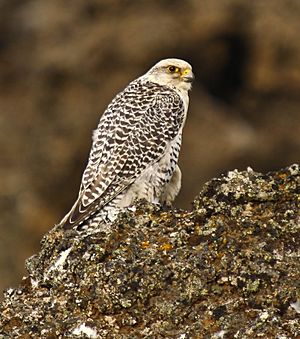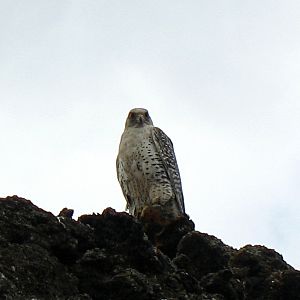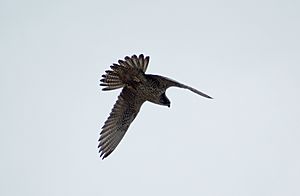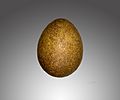Gyrfalcon facts for kids
Quick facts for kids Gyrfalcon |
|
|---|---|
 |
|
| Conservation status | |
| Scientific classification | |
| Genus: |
Falco
|
| Species: |
rusticolus
|
The gyrfalcon (Falco rusticolus) is the largest type of falcon in the world. It's a powerful bird of prey that lives in the Arctic. You might also hear it called a "gyr."
These amazing birds live and breed along the cold Arctic coasts, in the wide-open tundra, and on islands in northern North America and Europe. Most gyrfalcons stay in these cold places all year. However, some might travel further south after breeding or during winter. Sometimes, a single bird can fly very long distances!
Gyrfalcons come in many different colors, from pure white to dark brown. These color differences are called morphs. Like other falcons, female gyrfalcons are much bigger than males. For hundreds of years, people have valued the gyrfalcon as a skilled hunting bird. They mostly hunt birds like ptarmigan and waterfowl, often catching them in mid-air. They also eat fish and small mammals.
Contents
What's in a Name?
The gyrfalcon was first officially described by a Swedish scientist named Carl Linnaeus in 1758. He gave it the scientific name Falco rusticolus.
The first part, Falco, is a Latin word for falcon. It comes from a word meaning "sickle," which describes the bird's sharp talons. The second part, rusticolus, means "countryside-dweller" in Latin.
The common name "gyrfalcon" comes from an old French word. Some people think "gyr" might come from a German word for "vulture," because of how big the gyrfalcon is compared to other falcons. Others believe it comes from a Latin word meaning "circle" or "curved path." This could describe how the gyrfalcon circles in the sky when it's looking for food, which is different from how some other falcons hunt. A male gyrfalcon is sometimes called a gyrkin in falconry.
Meet the Gyrfalcon: Size and Colors
The gyrfalcon is a very large falcon, similar in size to the biggest types of buzzards, but often a bit heavier.
- Male gyrfalcons are about 48 to 61 centimeters (19 to 24 inches) long. They weigh between 805 and 1350 grams (about 1.8 to 3 pounds). Their wings can spread from 110 to 130 centimeters (43 to 51 inches) wide.
- Female gyrfalcons are bigger and heavier. They are 51 to 65 centimeters (20 to 26 inches) long. Their wingspan can be 124 to 160 centimeters (49 to 63 inches). They weigh from 1180 to 2100 grams (about 2.6 to 4.6 pounds).
The gyrfalcon is larger, has wider wings, and a longer tail than the peregrine falcon. Sometimes, gyrfalcons and peregrines compete for food.
Gyrfalcons are known for their many different colors, which are called morphs. You can find them in "white," "silver," "brown," and "black" forms. They can be anywhere on this color spectrum, from all white to very dark.
- The white gyrfalcons are the only falcons that are mostly white.
- Silver gyrfalcons look like a light grey lanner falcon, but much bigger.
- Brown gyrfalcons can be told apart from peregrine falcons by the creamy streaks on their neck and head. They also don't have the strong dark stripe near their eye that peregrines do.
- Black gyrfalcons have strong black spots on their underside.
Interestingly, males and females don't have different colors. Young gyrfalcons are usually darker and browner than adult birds.
Gyrfalcon Relatives
The gyrfalcon belongs to a group of falcons called "hierofalcons." These falcons often breed with each other, even different types! This means their family tree can be a bit tricky to figure out. For example, gyrfalcons sometimes breed with saker falcons in the Altai Mountains. This mixing of genes might have led to the "Altai falcon."
The color of a gyrfalcon can often depend on where it lives.
- Gyrfalcons in Greenland are usually the lightest, with white feathers that have grey flecks on their back and wings.
- Birds from Iceland tend to be pale.
- Gyrfalcons in Europe and Asia are generally darker, and you won't usually find white birds there.
Because gyrfalcons can fly long distances and mix with different groups, their colors can vary a lot. For example, one pair of captive gyrfalcons was known to have four chicks: one white, one silver, one brown, and one black!

Scientists have also found that gyrfalcons in Iceland are genetically unique compared to those in Greenland, Canada, Alaska, and Norway. This suggests they don't mix as much with other groups.
Ancient Gyrfalcons
Long ago, during the last ice age (about 125,000 to 13,000 years ago), there was a type of ancient gyrfalcon called Falco rusticolus swarthi. Fossils of these birds show they were a bit larger than today's gyrfalcons. They lived in warmer, drier areas and probably hunted land birds and mammals, unlike many American gyrfalcons today that eat seabirds.
What Gyrfalcons Eat and How They Hunt
Gyrfalcons were once thought to live only in tundra and mountains. But we now know they spend a lot of time on sea ice far from land during winter!
They eat only birds and mammals. Unlike the peregrine falcon that dives very fast from high up, gyrfalcons usually hunt by chasing their prey horizontally. Most of their prey is killed on the ground. If they catch a bird in the air, they often force it down to the ground.
Their diet can change depending on what's available. However, most gyrfalcons breed and hunt where there are lots of ptarmigan and seabird colonies.
- Bird prey can range from small redpolls to large geese. They also eat gulls, corvids (like ravens), small songbirds, waders, and even other raptors (like buzzards).
- Mammal prey can be tiny shrews or larger marmots (which can be three times the falcon's weight!). They often hunt lemmings, voles, ground squirrels, and hares. They rarely eat dead animals.
Climate Change and Gyrfalcons
In the early 2000s, scientists noticed something worrying. As the Arctic summers got warmer due to climate change, peregrine falcons started moving further north. This meant they were competing with gyrfalcons for food and nesting spots. Even though gyrfalcons are bigger and built for the cold Arctic, they are less aggressive than peregrines. Peregrines often attack and overpower gyrfalcons. There's a concern that gyrfalcons might disappear from some of their traditional hunting grounds in the future.
Life Cycle and Reproduction
The gyrfalcon almost always builds its nest on cliff faces. They don't build their own nests from scratch. Instead, they often use a bare cliff ledge or take over an old nest built by other birds, like golden eagles or common ravens.
- A female gyrfalcon usually lays 2 to 4 eggs, but sometimes it can be 1 to 5.
- Each egg is about 58.46 by 45 millimeters (2.3 by 1.8 inches) and weighs around 62 grams (2.2 ounces).
- The eggs hatch after about 35 days. The chicks weigh around 52 grams (1.8 ounces) when they hatch.
- The parents keep the nestlings warm for about 10 to 15 days.
- The young falcons leave the nest when they are 7 to 8 weeks old.
- By 3 to 4 months of age, the young gyrfalcons can take care of themselves. They might stay with their brothers and sisters through the winter.
Gyrfalcons don't have many natural enemies. Golden eagles are their only known predators, but even eagles rarely bother these strong falcons. Gyrfalcons are known to bravely chase away animals that come too close to their nests, even brown bears! However, common ravens are known to sometimes steal gyrfalcon eggs and young chicks.
The main causes of death for gyrfalcons are humans, either by accident (like car crashes or eating poisoned meat meant for other animals) or by hunting. Gyrfalcons that survive to adulthood can live for up to 20 years.
Because gyrfalcons live across such a large area, they are not considered an endangered species by the IUCN. They are not greatly affected by habitat destruction. However, pollution, especially from pesticides, caused their numbers to drop in the mid-1900s. They were even considered "Near Threatened" until 1994. Luckily, better environmental rules in many countries have helped the birds recover.
Gyrfalcons and People

Gyrfalcons have been important to humans for a long time, especially for hunting in the sport of falconry.
- The gyrfalcon is the official bird of Canada's Northwest Territories.
- The white falcon on the coat of arms of Iceland is a type of gyrfalcon.
- The white gyrfalcon is also the official mascot of the United States Air Force Academy.
In the Middle Ages, the gyrfalcon was seen as a "royal bird." It was so rare and hard to get that only kings and nobles were allowed to own one. A geographer from the 1200s even wrote that the Egyptian Sultan would pay 1,000 dinars for a live gyrfalcon!
In 12th-century China, hunting swans with gyrfalcons became popular among the Khitan nobility. When there weren't enough gyrfalcons, the Liao Emperor made the Jurchen tribes pay a tax in gyrfalcons. This led to the Jurchen rebellion, which eventually ended the Liao empire.
Many historians believe that the coat of arms of Ukraine, a medieval symbol, actually shows a stylized falcon, not a trident. Falconry has been a royal sport in Europe for centuries. The gyrfalcon is even mentioned in a 12th-century poem from Ruthenia called "The Tale of Igor's Campaign."
Scientists have also found that falcons are very sensitive to avian influenza. An experiment with hybrid gyr-saker falcons showed that vaccinated birds survived a dangerous bird flu strain, while unvaccinated ones died. This means that both wild and captive gyrfalcons can be protected from bird flu with vaccines.
See also
 In Spanish: Gerifalte para niños
In Spanish: Gerifalte para niños











